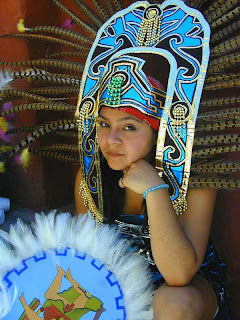 As many of you know, I first moved from Los Angeles to San Miguel de Allende, Mexico, in 2001, before Phoebe the Cat and I moved here to Buenos Aires. Just last month an anthology of writings about this lovely Colonial town was published, Solamente en San Miguel (Windstrom Creative), and I am honored that an essay of mine was included. Here it is for those who are curious, or who are yet unable to purchase the book. They are known by their shoes
As many of you know, I first moved from Los Angeles to San Miguel de Allende, Mexico, in 2001, before Phoebe the Cat and I moved here to Buenos Aires. Just last month an anthology of writings about this lovely Colonial town was published, Solamente en San Miguel (Windstrom Creative), and I am honored that an essay of mine was included. Here it is for those who are curious, or who are yet unable to purchase the book. They are known by their shoes. There is an irrefutable elegant air to these slim women of
a certain age, starting with the renowned
cocktail huaraches they wear on their feet. Often with heavy silver cuff bracelets, art-gallery earrings, classy straw hats protecting perfect blond highlights, these women are as frequently known for their good works as their good looks.
The culture of San Miguel de Allende, a picturesque colonial town in the highlands of central Mexico, seems to be moved and stirred by women, whether foreign or Mexican.

English-speaking Amazons from the United States and Canada have bought property, own businesses, and run the public library and festivals of art. In any tourist restaurant at any time are norteamericanas sitting alone with a book or a notebook, studying, learning, journaling, or in groups of like-minded free souls planning the next charity event or a stylish personal project. Sometimes superficial, always creative. (Overheard in a popular restaurant: “I just can’t decide between cinnabar, saffron, or eggplant for the sala.”) Their children come here from the States to marry, and often the lavish weddings include donkey processions, piñatas, exploding brides and grooms, mariachis, puppets, fireworks, and of course, the rental of one of the hundreds of gorgeous mansions and haciendas in San Miguel.

The much fewer expatriate men in evidence are sitting in the sun in the Jardin (the main plaza, sometimes called “Gringolandia” by the locals). Usually retirees dressed in shorts or jogging suits, they read the English language newspaper and watch the women, as the colors slowly change on the spires of the Parroquia. The full-time expat population stays at about 5,000 in a town of 50,000, but during the high seasons, the gringos seem to be everywhere.

Legend has it that there are thirteen women to every man in San Miguel. This includes Mexican women also, many of their men having gone north for work. The narrow cobblestone streets with steep, uneven sidewalks are filled with striking Mexican teenagers in tight jeans, young mothers carrying shawl-wrapped babies, women washing the sidewalks in front of their stores, tiny crones curled in doorways with knarled open hands, colorfully dressed Indian women marketing the pounds of beads over their arms, hawkers of dolls and baskets of dried flowers, women on the Jardin hacking coconuts open with a machete and selling the contents for ten pesos.

Whether Mexican, gringa or indigenous, there is no question that the women of San Miguel are a major, visible and vital presence in the town. Whether they were born in Mexico or have been adopted by it, the women are the ones who get things done.
Besides the Coldwater Creek-catalog gringas in graceful loose linen, there are the aging hippies, who are still trying to get by on art, blue denim and ethnic jewelry in lieu of hard currency. Wanting to change the world in the 60’s hasn’t dissuaded them from continuing to try in 21st Century Mexico, and they also volunteer, teach English, organize pet clinics, copy the artesanias of the Indians and make beaded jewelry, write letters to the editor of Atencion, the gringo newspaper, about ecology and social justice.

The New-age and holistic norteamericanas have a large clientele in the gringas who are exploring their spiritual sides, and they have made businesses out of teaching yoga, soul healing, dream interpretation, astrology, selling herbal medicine and feng shui advice. There for a while a decade or two ago Croning Ceremonies were a weekly event at the various hot springs outside of town. Solstice/Equinox celebrations at the Botanical Gardens continue to mark the seasons.
Foreign women move to San Miguel to forget a man, to find one, but above all to find themselves. Expatriates, and even tourists, can reinvent themselves, and every lady one meets professes to being an artist, writer, or psychotherapist. And why not? For most, it’s a chance to create a new life, and it’s now or never. Sometimes a gringa marries a young Mexican man and they go into a new business together, operating an inn, a restaurant, a gallery, a hair salon.

It is the women unconcerned with making a living or raising families who are now working to make a difference in Mexico, a country with so few social services. Middle age has found them to be comfortable financially, for the most part, or at least comfortable with doing without. Now they have a chance in their third age to contribute time, experience, knowledge, skill—and frequently, money.

Often without husbands or partners due to attrition or death, these capable women now have the independence to work for the underprivileged and handicapped, to express themselves finally in art, to learn Spanish, to access their spiritual sides, to raise money for hospitals and schools, to begin businesses, to build houses, to remodel convents into B & B’s. (Ironically they flock to a country where the women typically are not free from male domination to do whatever they like.)
Retired or independently wealthy and now denizens of Mexico, the freedom is liberating, and the feeling of “last chance” is everywhere. When asked why San Miguel, the answer always includes the fact that they feel safe there. (San Miguel was rated the third safest place to retire in the world by AARP).

The American women in San Miguel have seen enough--and suffered enough by the sheer strength of years--to actually have changed their value systems, the old ones were left up north with the BMWs and quite frequently, the husbands. Bitterness often lurks near the top of any conversation with a new transplant from the United States. Besides the popular conversational topics of real estate and library politics, newbies inevitably get around to past husbands.
If a number of these women have a great deal of money, they by and large don’t mind parting with some of it to benefit others. No gringo organization is without a favorite charity, and few foreign residents are too busy to volunteer because the obvious need is so great. Fundraisers are ongoing, from talent shows, cookbooks, lectures, raffles, rummage sales, home and city tours, any pleasant activity that can raise a few dollars for the needy, which are many.
Amazons in their strength, tall mature beauty, and determination to win—whether it’s new bathrooms for a country school, pre-natal care, or a last opportunity to be the artist or writer they had always planned on being and where did the time go?
They do all of this and still find the time to get pedicures and take cruises with their grandchildren.

Do the Mexicanas resent their northern sisters for taking over their town?

For attempting to change things, for having the time and money to try? Most likely the Mexican women are too busy themselves to pass judgment—or to even notice. Mexican women of San Miguel are the doctors and dentists, pharmacists, lawyers, hotel and business owners, and the holders of the most real estate in the municipality. The dictionary defines Amazon as “a notably tall, physically strong, strong-willed woman.” Though generally smaller in stature than their northern counterparts and less flamboyant, nevertheless the Mexican women of San Miguel de Allende are amazing Amazons in their own daily hardworking, quiet right.



































